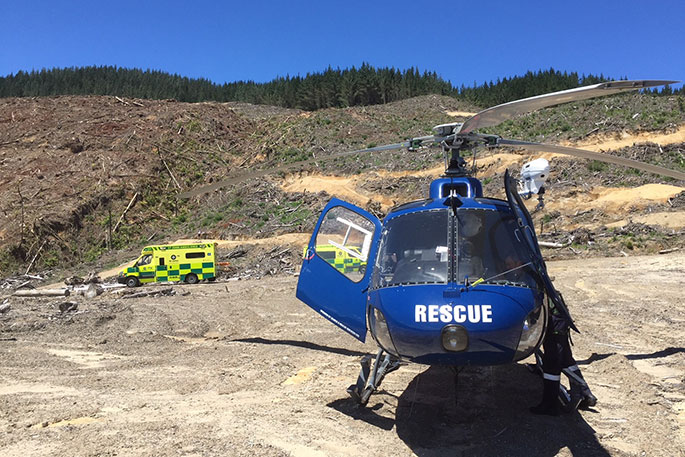There's been heated claim and counter claim by two of the region's Members of Parliament after a Rotorua man was critically injured on a forestry site.
The argument started when National's Rotorua MP Todd McClay blamed the Government over the accident.
'Locals deserve to feel angry,” said Todd. In return Labour's Waiariki MP Tamati Coffey accused him of fear-mongering.
The victim received an electric shock from powerlines at the forestry site where he was working.
Todd McClay says at the time the 35-year-old Tauranga rescue helicopter was out of service and the Taupo helicopter was deployed elsewhere.
'This was a serious incident” said the MP. 'Ambulances had to drive to the scene when a chopper would have been able to get there much faster.”
He claims no rescue helicopter was available and he blames the Government.
'Rotorua was given assurance that we would have a better rescue service and faster response times. Yet just two weeks after our chopper was taken away, it's been proven that this is not the case.
'There was only one rescue chopper available for the Bay of Plenty area most of this week and that is appalling. Rotorua needs its own rescue helicopter and the Government must reverse its decision to close our base.”
Waiariki MP Tamati Coffey says that's just not the case, the information is not factual. And that's when he accused the Rotorua MP of fear-mongering.
'The Ministry of Health has advised me that St John, which operates air ambulance dispatch, made the call that a road ambulance would be quicker in regards to the forestry accident, even though there was an air ambulance available.
'Along with our community, I trust their professional, highly-experienced opinion.”
Tamati's comments are supported by those of Lakes DHB chief executive Ron Dunham.
Ron says discussions between the paramedics attending the injured man and the National Air Desk ended with a decision to transport the patient to Rotorua Hospital by road in an ambulance.
The road journey took 19 minutes.
'Lakes DHB's transport co-ordinator contacted the Taupo pilot shortly after 1pm to arrange a chopper for 2pm, provided a flight nurse could be arranged.
'The pilot checked back with Lakes DHB, was told a nurse was being located and the patient prepared for transfer by air.
'The pilot was advised to leave Taupo Base for Rotorua Hospital just after 2pm, and arrived in Rotorua at 2.37pm, with an intensive care paramedic on board.
'The Lakes medical team transferred the patient, departing from Rotorua shortly before 3.30pm and arrived at Waikato at 3.50pm.”
Ron says while the Tauranga chopper was confirmed as being offline on scheduled maintenance, both the Waikato and Taupo based helicopters were fully available.
'The availability of the Waikato and Taupo choppers has been confirmed independently by the National Air Desk,” says Ron.
'Claims the rescue helicopter was ‘not available' are incorrect, as was the claim that ‘there was only one rescue chopper available for the Bay of Plenty area most of the week'. The choppers were fully available.
'There have been no issues with the new service that started on November 1, and it is disappointing when mistruths are bandied about, as they can impact the way people can have confidence in emergency services.”
Tamati Coffey says Todd McClay is playing false news politics and should know better.
'I will continue to ensure Waiariki's air ambulance needs and actual results are heavily monitored and reviewed throughout this period of change, in to ensure better health outcomes for our whānau.”
Earlier this year, Health Minister David Clark announced the Government would deliver safer, more modern and better resourced air ambulance services.
'We owe it to our communities to ensure that dedicated air ambulance staff and providers have the right tools for the job and are part of a well-coordinated national service,” said the Health Minister.
The average age of the current fleet of air ambulance helicopters is 29 years, and a third are single-engine.
Moving over time to twin-engine helicopters will reduce the risk of accidents and help meet stricter aviation requirements, says David.
'Our current air ambulance service has done a great job, but demand has risen and there are now more stringent aviation and clinical requirements. It is time to renew our helicopter fleet and ensure we deliver a consistently high level of service, with better patient outcomes nationwide.”



3 comments
Sounds like
Posted on 15-11-2018 18:59 | By Merlin
Sounds like CEO Ron Dunham has confirmed the decision to transport by Amubulance so this is just more scaremongering from National bit like the 7 billion fiscal hole to try and score political points.
Showman
Posted on 15-11-2018 19:04 | By Told you
Todd needs to pull his head in and only talk when it’s the truth, this is very dishonest politics.
Leverage
Posted on 16-11-2018 12:14 | By Hugh Janis
I have a great idea! Let's use someone's serious injury/death to gain political leverage! Way to go Mr. Politician. Enjoy your sleep. Do you get any?
Leave a Comment
You must be logged in to make a comment.